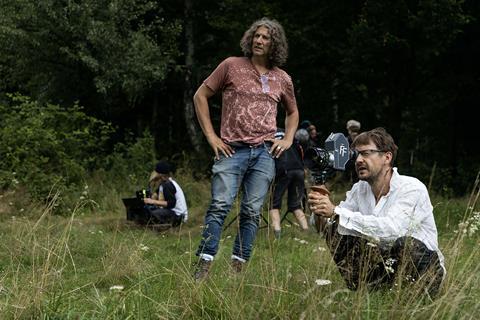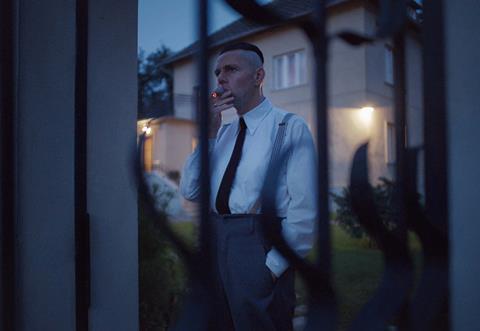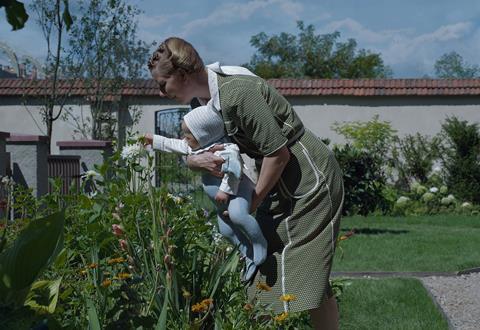With only his fourth feature in more than two decades, Jonathan Glazer explores the banality of evil in The Zone Of Interest, set right at the edge of the Auschwitz concentration camp. Screen reports on what propelled him to tell this story.

As both Jewish and a visual artist, Jonathan Glazer had long considered tackling the Holocaust in his work. But even now, having written and directed The Zone Of Interest — a film set in Auschwitz, home to the most infamous extermination camp of all where more than 1.1 million people, mostly Jews, were murdered by the Nazis in the Second World War — Glazer is still struggling to understand his interest in such bleak subject matter.
“I genuinely don’t know why it’s in me,” the UK writer/director reflects, the morning after The Zone Of Interest received its UK premiere at the BFI London Film Festival. “I’ve thought about it, a lot, since I started making the film. People said to me, ‘Why do you want to spend time with this imagery and this darkness?’ I’m still processing that. I’m Jewish and it’s sort of in you anyway. I don’t know why you take something on, really. I started to feel, was there something I could contribute, a corner that hadn’t been explored? I was already thinking about the perpetrator perspective but couldn’t figure out how.”
Then, in 2014, Glazer read Martin Amis’s recently published The Zone Of Interest, which told a fictionalised account of a camp commandant and his family. (The term ‘zone of interest’ was used by the Nazis to describe the 40-square kilometres surrounding Auschwitz in German-annexed Poland.) “Amis had done it in a way I hadn’t come across, and it became the kernel of it,” he says. “[But] I didn’t read the book and think, ‘I want to make that.’ I also didn’t read the book and think, ‘I didn’t want to make that.’”
Together with his longtime producer Jim Wilson, Glazer optioned Amis’s novel using their own funds. “We try not to connect ourselves to anything or anyone else at that stage, because we want to stay completely free with it, because I don’t know what it’s going to end up being,” says Glazer, who made his name in the 1990s with ingenious music videos — his promo for Jamiroquai’s ‘Virtual Insanity’ won video of the year at the 1997 MTV Video Music Awards — and stylish commercials (Guinness, Levi’s), before moving into features with 2000’s gangster thriller Sexy Beast. “It may end up being a 10-minute film. It may end up being a sound installation.”
Initial steps
Glazer began by making the first of many trips to Auschwitz and researching the archives, quickly realising that Amis had based the book on the camp’s commandant Rudolf Höss and his family, who lived onsite. “It became more and more fascinating how grotesquely familiar these people were, so I veered towards the history of it.”
At Auschwitz, Glazer visited the Höss family home, which he would later recreate on film, 50 metres from the real thing. “Saw the garden, saw the wall that divided the garden from the camp, then started looking at these pictures he had taken of his family in their golden summer days together, with a pool and everything.”
The photos were key. “I realised we were going to put ourselves on the perpetrator side of the wall and tell a story from there. And we were going to hear the atrocities being committed in the camp, but not see them.” But Glazer still did not have a story to tell. “I knew that, domestically, there’d be something so interesting about nothing going on; the more nothing it was, the better it was. Nonetheless, I needed something to propel on some level.”
Glazer and Wilson commissioned two archivists to search for any mention of the Höss family, from people who had worked in their house or camp survivors. “There were three lines here, a paragraph there, it was extraordinary every time we received this stuff,” he says. In the testimony of Stanislav Dubel — a gardener who was present the day Höss told his wife, Hedwig, he was being transferred to another camp and his family would have to leave with him — Glazer learned how Hedwig “hit the roof”. She refused to leave, saying she would have to be dragged out of Auschwitz. “That felt like that was going to be the axiom of it all,” he explains. “The idea that her home life, her bliss, her garden, her house, was just too wonderful to give up. The disassociation was so extraordinary.”
Once Glazer finished writing his script, he and Wilson approached several interested financiers, eventually going with A24, which had distributed their previous film Under The Skin in the US, and will release The Zone Of Interest in both the US and UK/Ireland; the UK’s Film4, which had financed Sexy Beast as well as Under The Skin; and the British Film Institute.
“It wasn’t necessarily the most money, but it felt like the right money,” notes Glazer. “We went with the people we knew, and people who knew us. I felt they would trust me enough to let me go on this journey until I got to a point where I could give them something that made sense of their trust. Because the way I film is very much a gathering of stuff. I don’t have all the answers until I finish. And even then, there are many questions.”
The shoot

The production filmed for 55 days across 18 months at Auschwitz (aka Oswiecim in Polish), in both summer and winter months. “It was awful,” says Glazer of filming at such an emotionally charged location. “There were days when you’re absolutely flattened by it, others where you just do your job. Where do I put the camera? Does that dress look good? You busy yourself with practice.
“I didn’t take this on lightly,” he continues. “I’m still in its grip. It’s still a very palpable and profound set of feelings I am uneasy with, but I tried to do everything I could to make a film that would remind us of our capacity for violence, how similar the perpetrator is to us, and how frightening that is. At the same time, honouring the memory of the people who perished there.”
Glazer’s directing approach was “to stand back and look at their actions, anthropologically, factually”. To achieve this, he and Polish cinematographer Lukasz Zal positioned up to 10 cameras inside and outside production designer Chris Oddy’s reconstruction of the Höss house and garden. They then filmed the actors — who included Christian Friedel and Sandra Hüller as Rudolf and Hedwig — in long, unbroken takes, to capture a reality rather than create drama, often shooting several scenes at once, which he dubbed “Big Brother in the Nazi house”.
“I wanted to remove as much of the artifice of filmmaking as possible,” says Glazer. “I wanted to put the viewer in the house with these people in real time; to feel this was happening now. That we were in the present tense. And it wasn’t fetishised in the way it’s very easy to do with the tools of cinema — close-ups and beautiful lighting. So we’d block very carefully, work out where those 10 cameras could go, and all the microphones.”
Once action was called, he would watch the scenes play out on a bank of monitors housed in a separate building. “I let them get on with it, then go in, talk to whoever I needed to talk to, adjust whatever we needed to adjust, retreat. Do the next. The great thing about filming this way is they’re not playing to any one camera, so there’s no self-consciousness, no performance, it’s just an existence,” says Glazer, who did something similar with the driving scenes in Under The Skin, in which Scarlett Johansson’s alien rode around Glasgow in a van fitted out with hidden cameras, picking up real people. “I didn’t want to dramatise. I was making every effort to avoid drama.”
But for a director as exacting as Glazer, it was a method that could be frustrating. “You would have this incredible scene where everything’s working and it’s miraculous, then something goes wrong and you would have to do it again,” he admits. “You couldn’t use the first part that went brilliantly because it’s trapped in the same real time as the rest of it that didn’t, because the light’s different, the movement’s different.”
Language barrier

Filming was complicated further by the fact his actors spoke German, and Glazer did not. “I couldn’t try to recreate this as accurately as possible and have English or American actors play these roles, so they had to be German. I started trying to learn German early on and failed miserably. To understand the nuance of a language, it must be your language, and I knew I could never get to that point.”
It helped that most of his cast spoke English. “So communication with them was no problem,” he says. “My first, naive thought was as long as they stay true to the script, and I’ve got my translator standing next to me to give me a thumbs up or thumbs down, we’ll be fine. But, within an hour, they were improvising. And I was encouraging them. We deviated from the script very quickly. When we started editing, I had to pick through it all with my editor and sound editor to see what I’d got.”
For Glazer, sound is as important as the visuals. With The Zone Of Interest, there is the film that is seen, and the film that is heard.
“They are different, intentionally,” he says. “The foreground film, the one we see, is largely uneventful, largely undramatic. But it is imbued by everything you hear. And what you hear bears down on every frame. The atrocities committed in the camps are perpetual, so there’s no quiet moment. There are certain scenes which are all about the sound. In other scenes the sound is ambient. A writer used the term ‘ambient genocide’, which I thought was very appropriate to this and what we protect ourselves from, what we disassociate from, to have our comfortable lives. The sound was a huge part, the sound is the other film, and, arguably, the film, for me.”
The Zone Of Interest — which won the grand prix at Cannes, and is the UK’s submission for the best international feature Oscar — took Glazer almost nine years to make, and is only his fourth feature in 23 years. “I can’t do it casually,” he explains of his slow and measured approach to filmmaking. “I have to be compelled to do it. There must be something in it that’s driving me forward. And often I’m not even sure what that is.
“I also don’t think I would be good at doing something I didn’t feel that way about,” he adds. “I genuinely don’t know where I would put the camera, or what I would say to the actor, or how I would put it together. To some extent I could do it, but I wouldn’t be engaged enough to do a good job. So, I guess I’m just on my path, whatever that is.”






![The Brightest SunScreen[Courtesy HKIFF]](https://d1nslcd7m2225b.cloudfront.net/Pictures/274x183/3/5/0/1448350_thebrightestsunscreencourtesyhkiff_312678.jpg)


















No comments yet